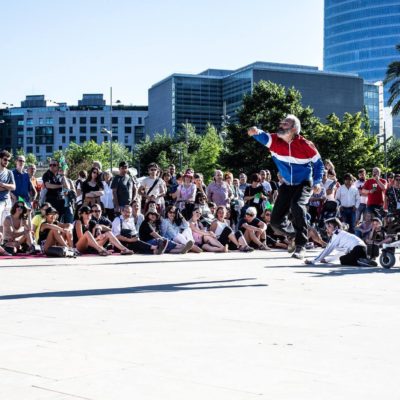Habrá Que Ponerse Cachas (HQPC) leger med mening, nonsens, charme og opfindsomhed.
Denne danseforestilling er inspireret af en Bob Dylan sang og filmen “The Royal Tenenbaums”. Ligesom begge inspirationskilder, stiller HQPC spørgsmålstegn ved forholdet mellem søskende, og hvordan det ændrer sig over tid: Hvordan udvikler søskendeforhold sig mellem barndom, ungdom og voksenliv, og hvad sker der, når børn skal træffe beslutninger for deres forældre? Hvad bringer os tættere på vores søskende? Adskiller os? Og hvordan er vores familie en del af vores identitet? Danserne udforsker dette gennem bevægelse og leg.
Maylis, kunstnerisk leder, har udviklet forestillingen i samarbejde med danserne, Ebi Soria og Xabier Madina, ud fra kreative værktøjer, ideer og ord. Denne forestilling og dens proces afspejler hendes vision om at skabe inkluderende dans. Danserne, med og uden handicap, er ligeværdige i skabelsen af bevægelsen, hver har sin plads i processen og på scenen. Der er fokus på kvaliteten af en bevægelse i enkelhed, absurditet, unikhed, medvirken og frem for alt de små detaljer, der gør forskellen og virtuositeten.
Habrá Que Ponerse Cachas is a game of meaning, nonsense, much charm, and ingenuity.
Habrá Que Ponerse Cachas (HQPC) is a playful and powerful inclusive dance-theater piece. It is inspired by a song by Bob Dylan,“The Royal Tenenbaums” by Wes Anderson and the roles of two characters in the film. How do relationships between siblings change over time, from childhood, adolescence, and adulthood? What brings us closer to our siblings? Separates us? How is family part of our identity? Drives us away? These flying ideas become a celebration of movement.
Maylis, artistic director, has worked more than a year in collaboration with the dancers, Xabier Madina and Ebi Soria, from creative tools, ideas, and or words. This piece and process reflects her vision of creation in dance. The dancers, with and without disabilities, are equal in the creation of the movement, each one has its place in the process and on stage. More than the technicality and the physicality of the dancing, what artistically makes sense to Maylis in this project is to find the quality of movement in simplicity, absurdity, uniqueness, complicity and, above all, the small details that make the difference and virtuosity.



